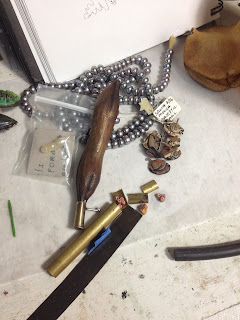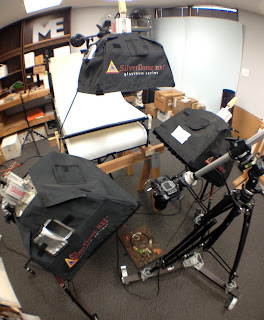Almost all artists keep sketchbooks. They are often
day-by-day chronicles of the artist’s thoughts and inspirations. They are also
the place where the artist works through the various concept, design and
fabrication issues associated with the process of taking an abstract idea and
making it into a concrete object.
Frequently, the process of making hides from the viewer of
the finished object. And “process” is the very essence of the expression, “art
makes the difficult seem easy.” We prefer “Art is Magic”, but we may be biased.
Behind the process is years of study and practice developing
skills with tools and materials. The effect is that everything falls magically
into place as if nature intended it that way.
Trust us when we say, making something almost NEVER happens like that.
So, how does it happen?
A recently completed necklace commissions will provide a
quick overview of our processes.
Our process starts with sketches. These can be one-offs to
help solidify the idea or a series of concept and engineering sketches to work
out the composition and mechanical issues.
Once we are clear about what we want to make, we assess the
materials and methods, and who will perform each task. A staging table is set up to hold components
that are complete.
The manufacture and sub-assembly of parts often incorporate
a considerable range of techniques and materials.
As we work out joining and how the various parts will hang
and interact, fittings are made for each component.
The process continues as shapes, colors, textures are
compared and fitted as the piece begins to take shape.
The project called for a custom display case to house the
piece. Once the piece progresses to a point where we can determine precise
physical dimensions, we begin constructing the case.
In this instance, we wanted to create a stylized forest
floor as an environment for the piece. This aspect of the project required
considerable trial and error. We spent time exploring and photographing details
of local forest floors, including collecting a variety of leaves to be used as
models later in the process.
Research complete, the next step was a series of technical
exercises to express the environments we had seen. We selected polymer for its
creative flexibility as the best-suited medium for the job.
The next step is when all the parts come together, and final
assembly and fit takes place. The fitting includes the piece itself, but also
the piece within its environment.
The final step is photography of the finished item. As you can see above, we are also documenting
the entire process as it happens. While
process photography is often fast and informal, final photography requires much
more time and careful attention to complete.
The finished piece in its custom case.
The project took two people ten weeks to complete start to
finish.
The materials incorporated in the piece include:
Acrylic paint
Bonksia Pod
Brass
Colored pencil
Copper
Glass
Gold
Gold leaf
Neoprene
Nickel
Oil Paint
Pearls
Polymer Clay
Sterling Silver
Tagua Nut
Various kinds of Wood
Various pigments and dies
Take a peek at the sketch books of some of our Etsymetal friends:
Cynthia Del Giudice: http://cynthiadelgiudice.blogspot.com
Beth Cyr: http://BethCyr.com/blog
Amuckdesign http://amuckdesign.blogspot.com
Take a peek at the sketch books of some of our Etsymetal friends:
Cynthia Del Giudice: http://cynthiadelgiudice.blogspot.com
Beth Cyr: http://BethCyr.com/blog
Amuckdesign http://amuckdesign.blogspot.com




































